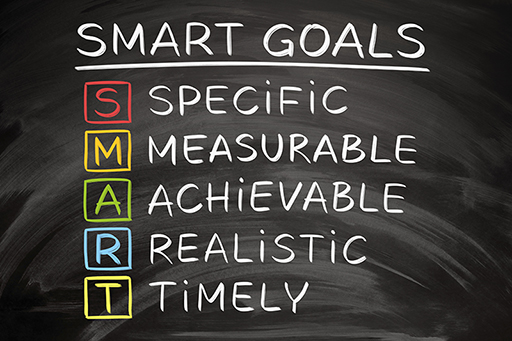2 Setting SMART goals
When you are setting yourself goals, it is important to make sure they are SMART. That means:
- S = Specific – is your goal specific and clear?
- M = Measurable – how will you measure your success?
- A = Achievable/attainable – is your goal attainable, do you have the ability to achieve it?
- R = Realistic – is your goal realistic in your context? Will it fit with other priorities in your life?
- T = Timely/time bound – make sure you give yourself a deadline for achieving your goal.
This Goal Setting tool [Tip: hold Ctrl and click a link to open it in a new tab. (Hide tip)] takes you through the SMART process and helps you to write down and plan your goals.
If this doesn’t resonate with you, there are other goal setting tools available, such as HARD (heartfelt, animated, required and difficult) and PACT (purposeful, actionable, continuous and trackable), which we don’t have time to cover in detail here, but that you can easily explore using your preferred online search engine.
Here is another way of breaking down each goal.
| Goal | To enhance my awareness of my own unconscious biases |
|
Current status:
|
|
| Development/training/knowledge needed to reach my goal | I need to practice reflecting on past opinions/actions |
| Action plan |
|
| Outcome (to be completed after a designated time period relevant to the complexity of the actions) |
I’ve now spent some time reflecting on past experiences/decisions etc. in my notebook, and I’m starting to identify times when I’ve displayed my unconscious biases. I’ve enrolled on an unconscious bias training course in January.
I’ve joined a working group looking at supporting disability in my workplace and have started to build connections with members of the group who have disabilities. |
| Evaluation | I have started to look at my working environment and the things I say to colleagues in a different way, and I want to share my learning with my team. |
| Next step | To investigate ways in which I can raise awareness of unconscious bias with my colleagues, particularly relating to our recruitment processes. |
| Goal | To build my personal skills to give me the confidence to call out discrimination when I see/hear it. |
|
Current status:
|
|
| Development/training/knowledge needed to reach my goal | I need to build my resilience and practice my allyship |
| Action plan |
|
| Outcome (to be completed after a designated time period relevant to the complexity of the actions) |
My employer hasn’t considered support for staff in tackling microaggressions, so I’m working with a member of the HR team to explore that in more detail.
I’m building a more trusting relationship with two colleagues and supporting them with the microaggressions they are regularly exposed to. |
| Evaluation | I am making small steps to improve, and will continue to do so. I have suggested to my employer that we have Diversity Champions in our office. |
| Next step | Create a resource with my HR colleague to build awareness about microaggressions in the workplace. |
These examples are of relatively short term goals that will move you forward incrementally, which is an approach that can work well with this type of personal development. Of course, this same process can also be used to consider medium or longer term goals.
Activity 3 Achieving your goals
Now it’s your turn! Use the template below to set goals and plan your next steps. For this activity, start with some short term goals.
If you have an alternative format you’d prefer to use, please do. You could also use the Goal Setting tool to make sure your goals are SMART.
| Goal 1 | |
|
Current status: a) Experience b) Knowledge c) Skills |
|
| Development/training/knowledge needed to reach my goal | |
| Action plan | |
| Outcome | |
| Evaluation | |
| Next step (include dates) | |
| Goal 2 | |
|
Current status: a) Experience b) Knowledge c) Skills |
|
| Development/training/knowledge needed to reach my goal | |
| Action plan | |
| Outcome | |
| Evaluation | |
| Next step (include dates) | |
| Goal 3 | |
|
Current status: a) Experience b) Knowledge c) Skills |
|
| Development/training/knowledge needed to reach my goal | |
| Action plan | |
| Outcome | |
| Evaluation | |
| Next step (include dates) |
Comment
If you have identified more than one goal, prioritise your plans. Are they sequential or can you do them all at once? Make sure you don’t take on too much – if you don’t achieve all your goals within the allotted time, this can be a negative experience.
You should now have a set of SMART, short-term, personal goals, and an action plan for achieving them.
In the next section, you’ll look at goals for your organisation.

